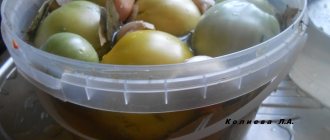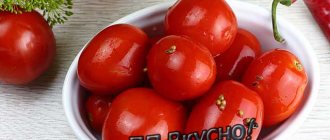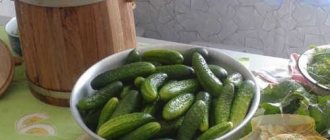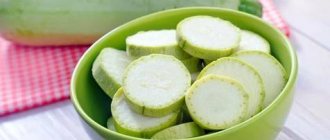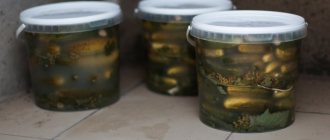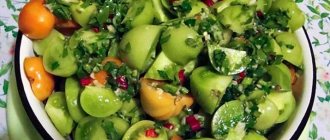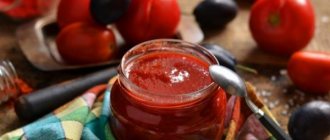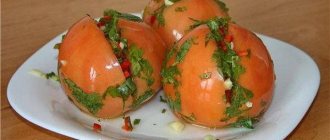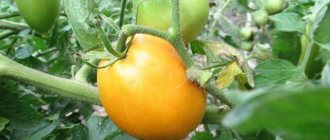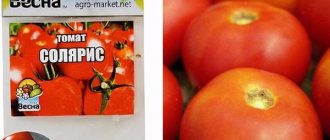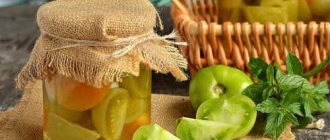How to choose tomatoes for pickling
Selecting high-quality fruits for pickling is the first and most important step on the path to obtaining tasty pickles, which is why it is so important to learn how to distinguish a good product from a low-quality one.
Did you know? Absolutely everything in salted tomatoes is valuable: the fruits can be eaten with a side dish, and the remaining brine can be used to prepare a lush and unusual-tasting dough, which is facilitated by the magnesium and potassium present in the composition.
There are several basic criteria for that “suitable” tomato:
- it must be ripe, but not overripe, otherwise the pickling will turn into mush;
- for pickling, it is advisable to choose varieties with thick skin that will not crack during heat treatment;
- It is better not to buy tomatoes with stalks, since ripe specimens would not hold on to it so well (green fruits will not be so juicy and soft, and they also contain solanine, a substance dangerous to humans);
- the color of the selected specimens should be uniform, without the slightest green areas;
- the smell of tomatoes suitable for pickling must be fresh and “tomato-like,” which cannot be said about many fruits grown for mass sale;
- You should not pay attention to overly bright and shiny tomatoes, because such an appearance may well indicate the presence of nitrate compounds in them;
- the surface of the selected vegetables should be even and smooth, without irregularities, growths and other deviations indicating the possible use of hormonal fertilizers during cultivation.
In addition, do not forget about the freshness of tomatoes. Rotten, crushed or diseased fruits should also be discarded. You can notice the presence of a problem by the appearance of tomatoes: for example, diseased fruits often have gray or dark spots, cracks, white spots and putrefactive lesions.
With mustard
- Time: half an hour (plus 2 days).
- Number of servings: 2-3 persons.
- Calorie content of the dish: 38 kcal.
- Purpose: preparation.
- Cuisine: Russian.
- Difficulty: medium.
The next preparation option is cold sourdough with mustard. There is enough food for a 3 liter pan. For the recipe, it is recommended to choose slightly under-ripe tomatoes, preferably cream varieties. The fermentation process takes 30-40 minutes to prepare and two days to obtain the result. If you do everything according to the recipe, the result will be a finger-licking appetizer.
- How to choose a smartphone for older people
- DIY drip irrigation
- Generic Levitra
Ingredients:
- currant leaves – 3 pcs.;
- ripe cream – 2 kg;
- bay leaf – 3-4 pcs.;
- fresh dill - 1 bunch.
Brine:
- water - liter;
- salt – 1 tbsp. l.;
- mustard powder – 20 g;
- peppercorns – 6 pcs.;
- sugar – 60 g.
Cooking method:
- To ferment, take a saucepan (3 l). Place some of the washed cream inside, currant leaves and bay leaves on top. Then - the remaining fruits.
- Make the marinade. Bring water to a boil, add salt, sugar and pepper. Boil for five minutes, add mustard, stirring the brine. Cool to room temperature.
- Pour marinade over vegetables and place in a cool place.
- Salting lasts two days.
How to salt tomatoes in a bucket
Pickling tomatoes in a bucket is in itself an unusual way of preparing tomatoes, but here there are many variations in the procedure. We invite you to consider several popular and very tasty recipes for pickling tomatoes in such containers.
Find out more about pickling cherry tomatoes.
Recipe 1 (red tomatoes)
The first recipe is a recipe for pickling tomatoes, which will taste like barrel fruits.
To prepare this pickle you will need:
- fresh tomatoes - 6.5 kg;
- hot pepper - 2 pods;
- fried oak chips - 10–15 pcs;
- horseradish leaves - 10 pcs.;
- cherry leaves - 15 pcs.;
- dill umbrellas - 10 pcs.;
- garlic - 4 heads.
Additional products will be needed to prepare the brine.
This list includes:
- black allspice - 10 pcs.;
- black peppercorns - 10 pcs.;
- cloves - 5 pcs.;
- water - 5 l;
- salt and sugar - 250 g each.
The process of preparing pickling is not much different from other preservation options, but at each stage there are still some nuances.
Important! It will be possible to take a salting sample no earlier than 1.5–2 weeks after salting.
The sequence of actions performed will be as follows:
- Tomatoes, dill umbrellas, horseradish and cherry leaves should be washed well, and the garlic should be peeled into cloves.
- Then place the first layer of tomatoes in a prepared clean bucket (the fruits should be pressed against each other as tightly as possible) and top it with a few horseradish leaves, currants, oak chips, and on top with cherry leaves, crushed garlic cloves, a few pieces of hot red pepper and dill umbrellas .
- Place a second layer of tomatoes and cover it with the same herbs and spices as the previous one. Alternating spices and tomatoes is carried out until the bucket is completely filled with them.
- Prepare a brine from the above products and, after cooling it, pour over the tomatoes.
- Take a round saucer and place it on top of the tomatoes, pressing down lightly.
- Cover the bucket with a lid and leave it in the room for a day. After this time, it will be possible to transfer the pickles to the basement or other cool place, where the workpiece can reach the desired condition.
Video: how to pickle tomatoes in a bucket (recipe 1)
Recipe 2 (red tomatoes)
This method of pickling tomatoes can be used both for harvesting in small buckets and for canning in jars. A characteristic feature of this option can be considered the absence of the usual horseradish leaves in the list of ingredients, but if you wish, you can still add them. The finished pickling is quite spicy and salty.
The following components are required:
- strong tomato fruits, preferably of the same size - 4–5 kg;
- currant and cherry leaves - 10 pieces each;
- a large bunch of dill and parsley;
- basil and tarragon - 2 bunches each;
- celery - 2-3 bunches;
- garlic - 1 large head;
- hot pepper - 1-2 pieces (to taste).
To prepare the brine you will need the following ingredients:
- cold water - approximately 2-3 liters (as much as will fit into a bucket filled with tomatoes);
- coarse salt - for 3 liters 9 tbsp. spoons
Having prepared everything you need, it’s time to move on to the actual salting process.
Did you know? Tomatoes help the body absorb glucose and insulin, which is very beneficial for people suffering from diabetes.
It consists of the following steps:
- Rinse all prepared fruits and herbs thoroughly and let the water drain a little.
- Rinse the bucket (or other container for pickling) well in warm water, preferably using soda or mustard powder.
- Take a knife and, before moving the tomatoes into the prepared bucket, make several small punctures in the petiole zone, that is, where the fruit was attached to the branch. Tomatoes should be placed in the bucket with the holes facing down.
- Having laid out the first layer closely, take a clove of garlic and cut it into small slices on top of the tomatoes.
- Following the garlic, place a few leaves of cherries and currants, a small bunch of purple basil, celery, parsley and dill. Place a few sprigs of tarragon on top of the dill.
- Having finished with the first layer, take the knife again, make punctures in the tomato fruits and lay out the second layer.
- Chop the garlic, place currant leaves, cherries, celery, dill, parsley and other greens that you laid on top of the first layer. Also, don’t forget about hot peppers, which can be cut into several pieces for convenience.
- Place the third layer of tomatoes, which will most likely be the last for a food-grade five-liter bucket. You can sprinkle another chopped clove of garlic on top of the tomatoes and cover them with herbs: cherry and currant leaves, celery, dill, basil, parsley (as a result, the tomatoes should be completely covered with herbs).
- Prepare a brine, for which you need to dissolve 9 tbsp in 3 liters of purified or well water. spoons of salt.
- Pour brine over the tomatoes, just enough to completely cover the fruits and herbs.
- Take gauze, fold it in several layers and, covering the pickling, sprinkle a layer of mustard powder on top (this will prevent mold from appearing).
- Fold the edges of the gauze up and press it on top with an inverted plate of suitable size (the diameter should match the diameter of the bucket itself).
- Cover the bucket with a lid, lightly pressing the plate, and place a tray or other container with sides under it, on which the brine that appears during the salting process will be collected (the lid does not always adhere hermetically to the bucket).
The finished pickling should be immediately taken out to a cool place or placed in the refrigerator, where the tomatoes can be well salted and the lid of the bucket will not swell.
Video: how to pickle tomatoes in a bucket (recipe 2)
Recipe 3 (green tomatoes)
Pickling green tomato fruits is an unusual preparation option, but with the right approach to completing the task, it can please you with delicious fruits for the winter.
In this case you will need:
- green tomatoes - 4–5 kg;
- dill - 3-4 large branches;
- celery - 3-4 sprigs;
- horseradish - 4 leaves;
- tarragon - 2-3 branches;
- currant and cherry leaves - 20 pieces each;
- garlic - 2 heads;
- coriander seeds - 1 tbsp. spoon;
- mustard seeds - 1 tbsp. spoon;
- bay leaf - 5–6 pieces;
- salt - 15–17 tbsp. spoons (depending on the amount of liquid used);
- black peppercorns - 0.5 tbsp. spoons;
- water - 3-4 l (not boiled, preferably purified).
It is better to carry out salting in a small five-liter bucket made of food-grade plastic, observing the following sequence of actions:
- First, wash the bucket of soda well, rinse the tomato fruits and herbs.
- At the bottom of the container, place several sprigs of celery, the same amount of dill, 2-3 torn horseradish leaves, a sprig of tarragon, 5-6 bay leaves, 10 cherry leaves, several heads of garlic (you don’t need to remove the husks). Also, along the bottom of the bucket you need to scatter 1 full tablespoon of coriander seeds, a similar amount of mustard seeds and about half a spoon of black peppercorns or a mixture of peppers.
- Place a layer of large tomatoes on the prepared green surface, then another layer of smaller ones.
- Cover the tomatoes with a few more bunches of dill, celery, horseradish and chopped garlic cloves.
- Place the last layer of the smallest fruits on top of the greens.
- Prepare the brine. To do this, take 3 full tablespoons of salt for 1 liter of water and stir until completely dissolved (for 5 kg of tomatoes you will need approximately 3-4 liters of liquid).
- Pour the brine over the tomatoes until they are completely submerged in the liquid.
- You need to put a weight on top of the vegetables (you can use a strong plate) and install a weight, for which a three-liter jar of water is perfect.
The process of preparing pickles will take at least two weeks, and during this entire time the workpiece should be in a warm room, preferably in the kitchen. After the specified time has passed, you can already take a sample from the pickling, serving salted tomatoes both as an independent snack and in combination with various side dishes.
Video: how to pickle tomatoes in a bucket (recipe 3)
Recipes for pickling and pickling
It is very difficult to grasp the line that separates salting and fermentation. Salting is storing food in a saline solution, and pickling is something between pickling and preservation using biological, i.e. lactic acids.
Many recipes now have signs of both fermentation and salting, so the difference in preparing tomatoes using these methods is not at all fundamental.
As noted earlier, we will pickle using the cold method, since it will take less time, the taste will be good, and the tomatoes will not lose their beneficial qualities.
Ingredients:
- Tomatoes (take the quantity based on how much will fit in a bucket or barrel)
- Salt (per liter of water you will need 2 tablespoons of salt)
- Sugar (tablespoon per 3 kilos of tomatoes)
- Chili pepper (4-6 pieces)
- Greenery
- Peppercorns
- head of garlic
- Salting utensils
To begin with, it must be said that the dishes themselves must be thoroughly washed, even if they were completely clean and no one touched them. A controversial statement, because microbes don’t care.
Rinse the tomatoes and peppers under running water. Immediately select any wrinkled or overripe vegetables and set them aside. They are not suitable for pickling, but they are ideal for ketchup or adjika.
Fresh herbs also need to be washed thoroughly.
What should be in greens anyway? Well, it’s difficult to give a specific answer here, since every housewife uses a proven set for years, “gotten” to her according to recipes from grandmothers and mothers. If you are cooking for the first time, you can take the following set: dill (the sprigs should be with the umbrellas), celery, parsley, bay leaf, cherry, currant and horseradish leaves.
Now thinly slice the entire green set, except for the leaves, to match length and approximately the same thickness. Mix it to form a homogeneous green mass. Place it on the bottom of the bucket so that it is completely covered. Add a couple of bay leaves, the same number of clove buds, 2-3 allspice peas and 8-10 black peppercorns. The chili pepper can be cut into pieces, but it is not necessary.
Let's start preparing the brine. Assume that a container of, for example, 10 liters will need about 5 liters of brine. However, make sure to fill the bucket to the brim. Dissolve the required amount of salt (10 tablespoons for the same 5 liters of water) in water and fill the bucket with brine.
Place a wooden circle on top, press it down with something and cover it with a napkin. Let the tomatoes sit at room temperature for a few days to allow the fermentation process to begin, and then store them in a cool place.
After about 2 weeks, start tasting your pickles.
Read also: Fried eggplant caviar in a frying pan, recipe with photos
What can you serve with?
In winter, pickled and beautifully decorated vegetables can become a real decoration for the holiday table, and not to mention the possibility of using them as an appetizer for more modest events. They can be served with mashed potatoes, vegetable casseroles, or as a component of pizza or pie. Sometimes real masterpieces of first courses are prepared from salted red tomatoes, such as Siberian cabbage soup, and vegetable salads based on them.
Important! When using pickles when preparing dishes, do not forget about the high salt content in them, which will also affect the taste of the prepared dishes. It is likely that some of them will not need to be salted at all.
Georgian tomato recipe
- Time: 1 hour 40 minutes (+ 10 days).
- Number of servings: 8-10 persons.
- Calorie content of the dish: 38 kcal.
- Purpose: preparation.
- Cuisine: Georgian.
- Difficulty: medium.
Delicious, appetizing, spicy Georgian-style tomatoes are a fermented preparation that is impossible not to appreciate. Firm green tomatoes are stuffed with seasonings, herbs and filled with marinade. If you need to preserve the snack until winter, then when the fermentation is over, it is filled to the brim with brine and covered with lids . The Georgian-style preparation is salted for 10 days.
Ingredients:
- green cream – 10 kg;
- garlic – 1 kg;
- bay leaf – 6 pcs.;
- celery stalks – 1.5 kg;
- salt – 700 g;
- parsley – 100 g;
- capsicum hot pepper – 100 g;
- water – 10 l.
Cooking method:
- Remove the seeds from the pepper and chop it with a knife. Mix with chopped garlic, herbs, celery stalks.
- Cut the tomatoes down the sides to the middle. Stuff them with spicy mixture. Place in jars in layers, alternating with bay leaves and seasonings.
- Boil water and dissolve salt in it. Cool the marinade.
- Pour the brine into jars and place the green tomatoes under pressure.
- Ferment in the room for 3 days, and then place in a cool place.
- Cook for 10-12 days.
Rules for storing workpieces
Most pickles are almost immediately placed in the cellar or, in extreme cases, on the bottom shelf of the refrigerator, however, the latter solution can be considered appropriate only for a small number of preparations. The ideal storage temperature in both situations is considered to be +1...+6 °C. If there are no possibilities for long-term storage of salted tomatoes, then they can be preserved.
After five days of aging in brine, it is drained, and the fruits themselves and all the green seasonings used with them are washed with warm water. In this form, they are placed in clean jars, and the previously drained brine is brought to a boil. At the end of the procedure, the tomatoes placed in jars need to be filled with prepared brine and rolled up. Of course, the shelf life of rolled pickles will be much longer than the shelf life of vegetables in a bucket.
With garlic and herbs
- Time: 40 minutes (+ 2 weeks).
- Number of servings: 2-3 persons.
- Calorie content of the dish: 22 kcal.
- Purpose: preparation.
- Cuisine: Russian.
- Difficulty: medium.
It is very easy to diversify a standard daily meal by serving salted tomatoes with herbs and garlic. They are fermented in a three-liter glass jar or other convenient container. To make the taste of the preparation as rich as possible, cherry and currant leaves, dill inflorescences, fresh parsley, as well as your favorite seasonings, spices, and herbs are added to the fruits.
Ingredients:
- garlic – 4 cloves;
- cream – 2000 g;
- parsley - a bunch;
- salt – 50 g;
- blackcurrant and cherry leaves - 3 pcs.;
- water – 1.3 liters;
- dill inflorescences – 1 piece.
Cooking method:
- Wash the tomatoes, remove the stems.
- Peel the garlic and finely chop it with a knife. Rinse the greens with water.
- Place parsley sprigs, garlic, currant and cherry leaves, and a dill umbrella on the bottom of the pan.
- Place cream on top.
- Mix water with salt, pour brine into the contents of the pan.
- Place under pressure and put in the refrigerator.
- Appetizing pickled tomatoes can be tasted after 2 weeks.
Useful tips
For beginners, even the simplest pickling process can be a difficult task, but over time, every housewife will notice some nuances that make it much easier.
The most common recommendations for preparing such preparations include the following:
- if you want the process of pickling tomatoes to go faster, you need to make a cross-shaped cut at the base of the fruit;
- for greater aroma of the preparation, it is advisable to pre-dry the dill and parsley, so that during the pickling process they will reveal their full aromatic potential;
- It is advisable to pickle the fruits of ripe and soft varieties of tomatoes in containers with a volume of no more than 50 liters, and hard or green tomatoes in wooden barrels;
- in order not to crush ripe fruits, they must be laid out in layers, each of which must be covered with leaves of cherries, horseradish, currants, basil, dill and other herbs;
- The optimal pickling time is 2 weeks, after which it is advisable to transfer the tomatoes to another clean container or roll them into jars for longer storage.
Pickled in jars for the winter
- Time: about an hour (+ month).
- Number of servings: 5-8 persons.
- Calorie content of the dish: 23 kcal.
- Purpose: preparation.
- Cuisine: Russian.
- Difficulty: medium.
When you want to diversify the range of winter preparations, this recipe with photos comes to the rescue. Pickled green tomatoes for the winter (it’s better to use cream) will be an ideal addition to lunch or dinner; they simply melt in your mouth. The savory dish has an unusual aftertaste and appetizing aroma. The products indicated in the recipe are enough for 6 liters.
Ingredients:
- green cream – 2 kg;
- salt (without iodine) – 120 g;
- garlic – 1 pc.;
- bay leaf – 4 pcs.;
- allspice – 5 peas;
- cloves – 5 pcs.;
- black peppercorns – 20 pcs.:
- parsley - a bunch;
- horseradish and currant leaves, dill seeds - to taste.
Cooking method:
- Parsley must be washed, chopped, mixed.
- Black and allspice, bay leaves, dill seeds, cloves and a quarter of the herbs are placed in two three-liter jars.
- The marinade for fermentation is made from boiled water (0.5 l) and salt.
- Place the cream in a glass container, alternating it with cloves of unpeeled garlic.
- Place the remaining currant and horseradish leaves on top.
- Fill the food with hot brine to the top, cover with plastic lids, and turn the neck down.
- The fruits should be kept in the room for three days, and after the fermentation process begins, the jars should be placed in the cold.
- Fragrant, pickled tomatoes for the winter will be ready in a month.
